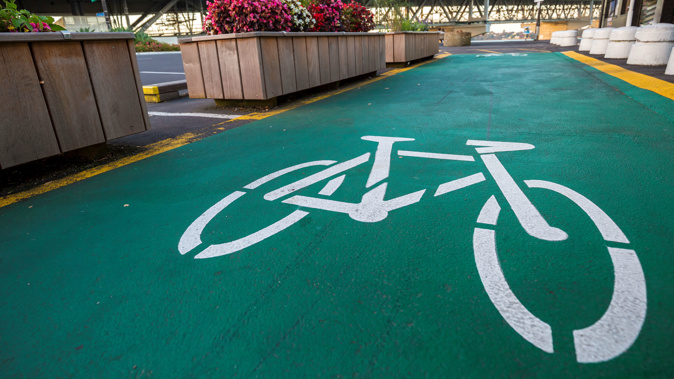
E-scooter and e-bike operators should be relatively happy with a long-awaited discussion paper released by Associate Transport Minister Julie Anne Genter this morning.
The "Accessible Streets" document, which will help shape pending law changes, takes a relatively light touch.
Under its proposals, e-scooters get to stay on footpaths (albeit with a speed limit), where they will be joined by e-bikes and cycles (currently barred from the pavement), helmets won't be made mandatory, and the recent International Transport Forum recommendations for low-power vehicle riders to be subject to the same drink-drive rules as motorists, and an end to per-minute charges that incentivise speeding and running red lights.
Cycles and e-bikes would be allowed on footpaths under Accessible Streets' proposed changes. Currently, only children's cycles are allowed on the pavement.
How close cars can get to low-powered vehicles is also addressed.
"To keep people safe on the road we're suggesting a minimum overtaking gap of either 1 metre [under 60km/h] or 1.5 metre [over 60km/h] for motorists when passing people riding horses, riding devices like e-scooters, cycling, or walking on roads without footpaths – which we know is a gap most people already try to give," Genter said.
"1 metre is terrifyingly close; too close for a margin of safety", safety campaigner Lance Wiggs says.
Wiggs also questions the discussion document's line on helmets. It says: "We're not addressing the current rules around wearing helmets as part of Accessible Streets. This means cyclists must still wear helmets on cycle paths, cycle lanes and the road. We encourage people using unpowered and powered transport devices to wear helmets, but this won't be compulsory."
Wiggs asks why helmets weren't in scope. And, contrary to what you might expect from a safety campaigner, he opposes mandatory use.
"Compulsory helmets lower cycling participation, as it did when introduced in NZ and many other places, and the loss of fitness and health benefits outweigh any increased risk," he says.
More, the perception of people driving vehicles is that the helmets somehow make the cyclists safe, and they tend to drive more aggressively versus the cyclists," he adds.
"The emerging issue is that police are harassing cyclists not wearing helmets - or on the footpath seeking safe passage - when the far greater risk is from the light and heavy vehicles on the road in front of them."
Wiggs is also irked that "addressing dangerous driver behaviour such as distracted driving and driving in or blocking bike lanes, here we need to see more enforceable rules and appropriate penalties." was also out-of-scope.
I'd also like to see stark clarity about who is presumed to be at fault in a crash. The presumption should be that the driver/rider of the heavier vehicle is at fault - i.e. car versus bike the car driver is presumed to be at fault, and bike versus pedestrian the bike rider is presumed to be at fault. This works well overseas, and penalties need to not just be appropriate but actually enforced.
The central government law changes are necessary because councils only have very limited powers to regulate where we drive or ride.
The document suggests low-powered (under 300 watts and narrower than 75cm) vehicles can stay on footpaths, albeit with a speed limit of 15km/h (most e-scooters and e-bikes can hit a top speed of double that). It says there should be "courteous" behaviour.
Wiggs said he was not happy with the 15km/h speed limit, but noted that local authorities would get the new power to lower it.
The document says helmets should stay compulsory for bikes, but remain recommended but not obligatory for e-scooters - which have so far racked up more than $6.2 million in ACC costs since October 2018 when the first ride-share operator, Lime, launched in NZ, including at least 99 concussion or brain injuries and 125 dental injuries.
Accessible Streets also suggests an update to the law so e-scooter riders can legally travel in all cycleways. Up until now, the practice has been technically illegal, if not enforced.
The ITF report said intoxication was a significant factor in traumatic e-scooter injuries. It recommended e-scooters and e-bikes be subject to the same drink-drive laws as other vehicles.
Although Accessible Streets does not address that issue, Auckland Council managers recently told the Herald they had an app-based test in the works to stop - or at least make it harder - for intoxicated people to unlock rideshare e-scooters.
The document does propose a series of road-rule changes to:
- Allow cycles and transport devices to travel straight ahead from a left-turn lane.
- Allow cycles and transport devices to carefully pass slow-moving vehicles on the left, unless a motor vehicle is indicating a left turn.
- Give cycles and buses priority over turning traffic when they're travelling through an intersection in a separated lane.
- Give priority to footpath, shared path and cycle path users over turning traffic where the necessary traffic control devices are installed.
Rideshare e-scooter operators have been approached for comment (Uber and Neuron both welcomed Accessible Streets but did not address any of its specifics in their first-blush remarks).
Although the document is generally favourable, one issue they are likely to pick up on is the 300-watt definition for a low-per vehicle able to travel on footpaths.
The new, larger Segway Ninebot Max - a favourite with e-scooter operators - has a 350-watt electric engine.
However, that definition is something that could be tweaked after the discussion phase, which begins today.
"Overall this seems to be about codifying existing behaviour rather than allowing new behaviour," Wiggs said.
"So it's a big step in the right direction, and will promote a healthy - and perhaps unhealthy - discussion."
- The report can be read, and submissions made, online here.
Take your Radio, Podcasts and Music with you









